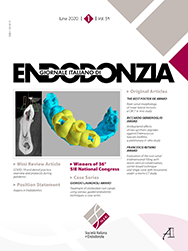Original Articles
Vol. 34 No. 1 (2020)
Accuracy, sensitivity and specificity of three imaging modalities in detection of separated intracanal instruments
Publisher's note
All claims expressed in this article are solely those of the authors and do not necessarily represent those of their affiliated organizations, or those of the publisher, the editors and the reviewers. Any product that may be evaluated in this article or claim that may be made by its manufacturer is not guaranteed or endorsed by the publisher.
All claims expressed in this article are solely those of the authors and do not necessarily represent those of their affiliated organizations, or those of the publisher, the editors and the reviewers. Any product that may be evaluated in this article or claim that may be made by its manufacturer is not guaranteed or endorsed by the publisher.
Received: 15 February 2020
Accepted: 25 February 2020
Accepted: 25 February 2020
766
Views
397
Downloads











